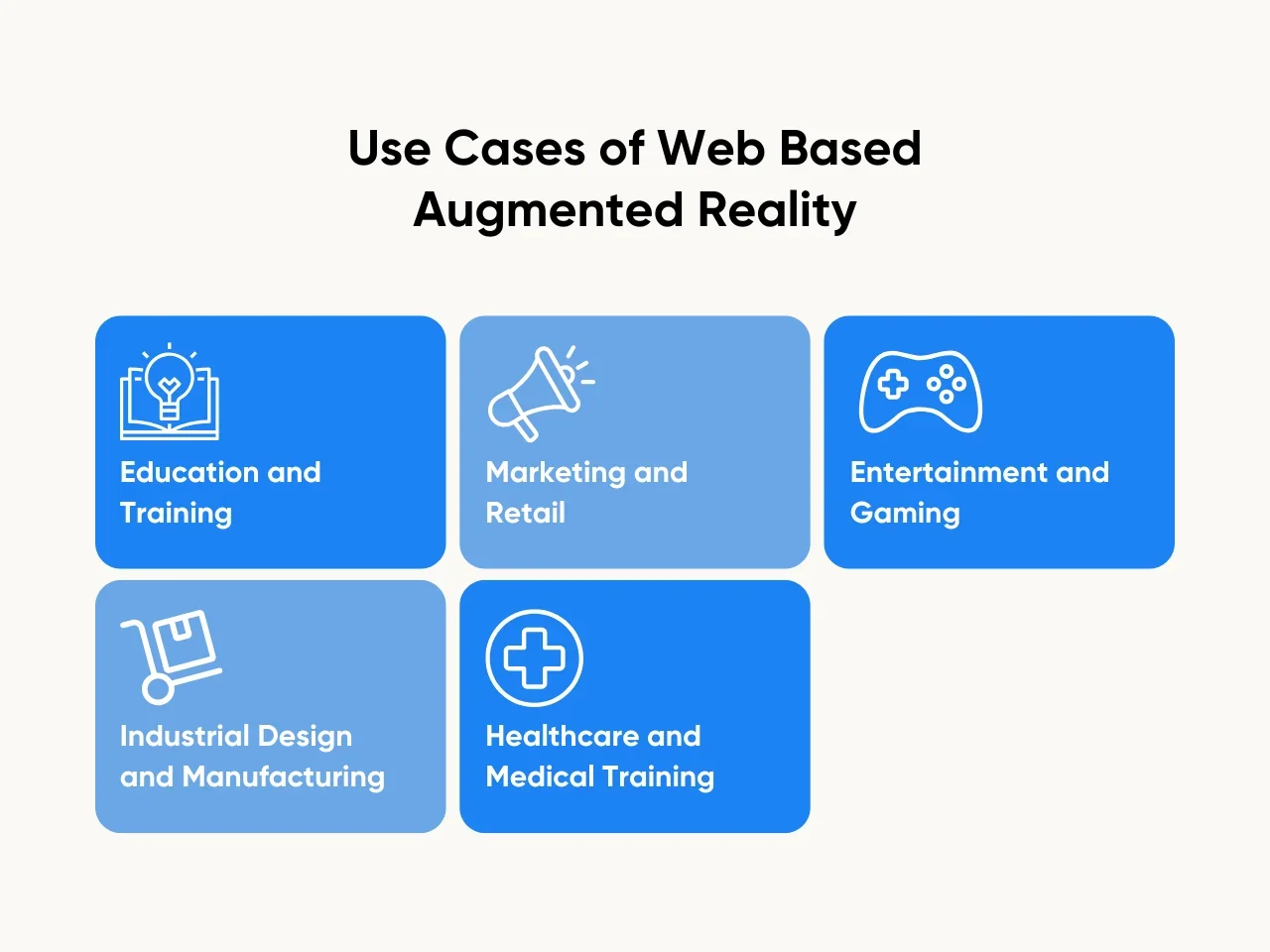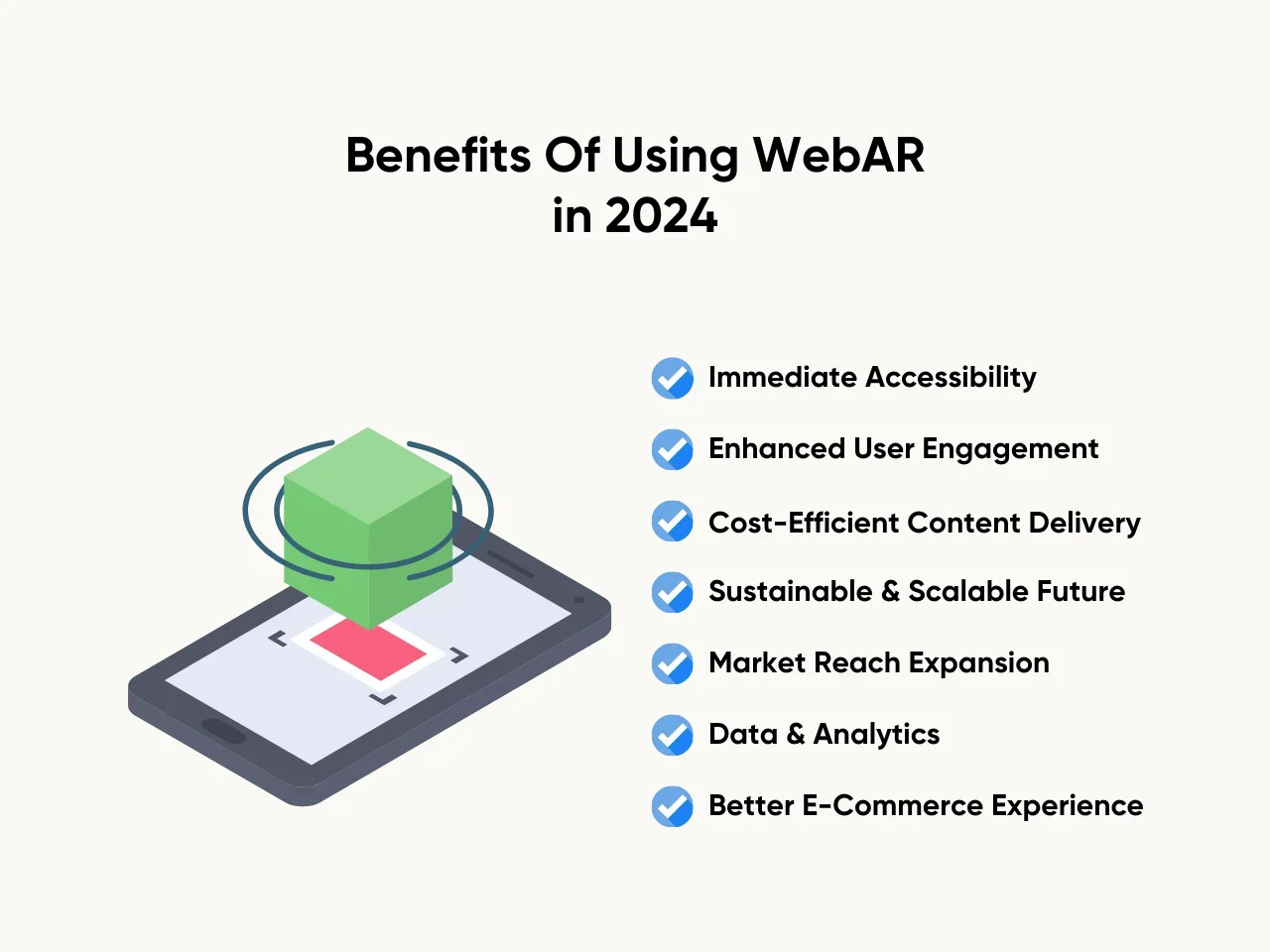Web based augmented reality (WebAR) provides a significant leap in digital experiences that combine real and virtual elements. It is a key to unlocking immersive, interactive experiences like never before. WebAR is not just enhancing the user experience but reinventing it, inviting us to rethink the way we engage with the digital world.
With an understanding of the critical role WebAR plays, Aloa understands the transformative benefits of WebAR for startups and software developers. Aloa keeps abreast of the latest industry trends and innovations, assuring startups to benefit from advanced technology and leverage the WebAR for streamlined operations as industries continue to evolve.
In this blog, you'll discover the transformative power of web based augmented reality, from its foundational technology to innovative applications. We will discover its impact on user engagement and the industries it’s poised to revolutionize. Afterward, you'll gain insights and strategies to leverage web based augmented reality. This will set you up to successfully use WebAR technologies, tailored to your specific needs and goals.
Let's get started!
What Is Web Based Augmented Reality (WebAR)
Web based augmented reality (WebAR) is a state-of-the-art technology that blends digital components into the real-world environment through a web browser as a medium. It removes the need for individual applications, enabling the websites to produce augmented reality experiences.
With many interactive possibilities of WebAR to smartphones and other devices, it makes it easily shareable through social media platforms. This is especially important considering there is an ever-growing demand for tech-driven marketing and advertising strategies.
WebAR is becoming an essential tool for businesses to engage with customers by allowing them to view services, apps, or products from using iOS and Android devices.
How Does Web Based Augmented Reality (WebAR) Work?
%20Work.webp)
Web-based Augmented Reality (WebAR) operates directly through web browsers, eliminating the need for specialized apps. It uses the device's camera to overlay digital content onto the real-world environment, accessible via URLs or QR codes. This simplicity broadens AR's accessibility, allowing instant interaction with augmented content on smartphones and tablets.
Furthermore, WebAR utilizes a blend of technologies including WebGL for rendering 3D graphics, WebRTC for capturing video, and various other HTML5 and JavaScript APIs. This tech ensemble enables WebAR to function on most modern browsers. The result is a frictionless user experience where augmented content can be summoned with a simple click or scan, making AR campaigns more scalable and instantly captivating for users worldwide.
Key Technologies and Frameworks of WebAR
WebAR's foundation is a sophisticated combination of technologies and methodologies, each contributing to creating seamless AR experiences accessible through web browsers.
Here are a few core components that empower WebAR:
- Computer Vision: Enables devices to make sense of the real world by interpreting visual data. It’s the backbone of the interaction between digital augmentations and physical spaces, allowing for a realistic blending of two worlds.
- AR Frameworks and APIs: Provide developers with the tools and interfaces to craft and deploy WebAR applications. They streamline the process of integrating AR content into web apps, making development more efficient and accessible.
- Web Technologies: The trio of HTML, CSS, and JavaScript forms the foundation for building web-based applications, including those exploiting augmented reality. These technologies define the layout, and functionalities of WebAR experiences, allowing them to run smoothly across different browsers and devices.
The Universality of WebAR Experiences
One of the most remarkable attributes of WebAR is its universal nature, democratizing access to AR by leveraging the widespread availability of internet browsers. This opens up an advanced AR experience that is just a URL click away, making it more accessible and inclusive than ever before. Its universality include:
- Browser-Based Accessibility: Prerequisites for accessing WebAR experiences, in which it catapults AR from a niche technology to a mainstream digital interaction tool for reaching a wide audience.
- No Apps Needed: The traditional barriers associated with app-based AR experiences, such as app store approvals, downloads, and storage concerns, are entirely dismantled by WebAR. Users can instantly access AR content without installing apps, broadening the technology’s reach and appeal.
Use Cases of Web Based Augmented Reality
Web based augmented reality (WebAR) is constantly changing how we interact with digital content, seamlessly integrating it into our physical world. Harnessing the ubiquity of web browsers, WebAR bypasses the need for specialized apps. It makes immersive AR experiences readily accessible to a broader audience.

Below, we’ll explore the transformative use cases of WebAR across different sectors.
Uses of WebAR in Education and Training
Web based augmented reality sheds a layer of interactivity and immersion to learning experiences that were previously unimaginable, making education more engaging and interactive. Notable applications include:
- Virtual Laboratories: Enable students to perform scientific experiments in a controlled, digital environment. This safe, scalable approach allows for exploratory learning without the risk or expense of real-life lab setups.
- Historical Reconstructions: Through WebAR, learners can virtually visit ancient sites or view artifacts in 3D, providing a dynamic way to explore history beyond textbooks.
WebAR Use Cases in Marketing and Retail
Marketing and retail have been particularly adept at leveraging WebAR to create unique customer experiences that engage and personalize the shopping journey. Some use cases include:
- Virtual Try-Ons: Empower consumers to visualize products (clothing, accessories, cosmetics, etc.) without needing a physical try-ons, helping decision-making process.
- Interactive Advertisements: Infusing traditional ads with AR transforms passive viewership into an interactive experience, enabling brands to engage consumers in novel ways. This enhances brand recall and encourages direct interaction with the product or service.
Entertainment and Gaming in WebAR
WebAR enriches the entertainment and gaming industries by adding a layer of immersive interaction that heightens user engagement and enjoyment. Key uses include:
- Augmented Reality Games: Blend virtual elements with the real world, offering unique gameplay experiences that are both engaging and accessible.
- Interactive Media: Incorporating WebAR into movies, concerts, and other media formats offers viewers a participatory role, making content consumption more dynamic and personal.
WebAR in Industrial Design and Manufacturing
The integration of web based augmented reality in the design and manufacturing process facilitates visualization and prototyping, streamlining workflow and enhancing the efficacy of production. Applications include:
- Virtual Prototyping: Designers and engineers can visualize their prototypes in real environments, facilitating immediate feedback and reducing the iterative product development cycle.
- Maintenance and Training: WebAR provides intuitive, step-by-step visual guides for complex machinery operations or maintenance, improving task efficiency and workplace safety.
WebAR Use Cases in Healthcare and Medical Training
WebAR is poised to revolutionize healthcare education and patient care by offering tools for visualization and training that enhance learning and operational precision. Some key use case are as follows:
- Surgical Visualization: Augmenting real-time surgery with overlays of patient-specific anatomy or procedural guidance offers surgeons unprecedented visual support, potentially reducing risks.
- Medical Education: Using detailed, augmented 3D models, medical students can gain a deeper understanding of human anatomy and surgical procedures, supplementing traditional learning methods with interactive visual aids.
Overall, WebAR's versatility across these sectors showcases its ability to enhance both the digital and physical realms, making it a technology that continues to expand its influence. As businesses move forward, assessing this technology's impact and the added advantages it can bring plays a pivotal role in shaping their promising digital future.
Benefits Of Using WebAR in 2024
In 2024, the benefits of using web based augmented reality are becoming increasingly compelling. It enables companies to engage customers, streamline operations, and drive innovation in immersive ways. Let’s explore the essential key benefits of this technology.

Immediate Accessibility
A quick and unrestricted access is one of the standout features of WebAR, making it a champion of convenience and spontaneity. With immediate accessibility laying the groundwork for the user experience, WebAR takes user engagement to a new level:
- No Download Required: Users can access an immersive augmented reality experience directly from their web browsers, eliminating the need for app downloads and streamlining the entry process.
- Cross-Device Compatibility: WebAR supports various devices, including smartphones, tablets, and digital eyewear, ensuring that experiences are not limited by device type.
- Link Sharing: Sharing AR experiences is as easy as sending a URL link, facilitating the viral spread of content and increasing its reach exponentially.
Enhanced User Engagement
Web based augmented reality significantly increases user engagement by transforming passive viewers into active participants. Here are how it becomes possible:
- Interactive Ads: Static advertisements evolve into engaging, interactive experiences, capturing user attention and fostering a deeper connection with the brand.
- Live Events: By overlaying digital enhancements onto real-world events, attendees can experience additional layers of interaction and immersion, adding value and novelty.
- Education and Training: Augmented reality introduces a hands-on component to learning and training programs, making complex concepts easier to grasp and remember.
Cost-Efficient Content Delivery
WebAR's streamlined approach to content delivery offers economic benefits that affect both developers and end-users through:
- Reduction on Development Costs: The need for multiple app versions for different platforms disappears, leading to lowered costs in development, distribution, and maintenance.
- Real-Time Updates and Deployment with Ease: Web based augmented reality allows real-time updates pushed directly to the web, ensuring all users have immediate access to the latest content without manual updates.
Sustainable and Scalable Future
WebAR provides a foundation that supports and enhances their development pathways as businesses grow and evolve. Here are how it shapes a sustainable and scalable future:
- Eco-Friendly Footprint: Eliminating the need for physical promotional materials, companies can enjoy a greener footprint while engaging their audience effectively.
- Easily Scalable Infrastructure: web based augmented reality platforms are designed to handle increasing loads smoothly, ensuring that scalability is never an issue.
Market Reach Expansion
WebAR dilutes the barriers of geography and accessibility, allowing brands to touch every corner of the globe effortlessly. Key benefits include:
- Global Accessibility: The only requirement for accessing WebAR content is an internet connection, making it possible to reach an international audience with minimal effort.
- Language and Localization: The adaptability of web based augmented reality to support multiple languages and local content significantly broadens its appeal across diverse user demographics.
Data and Analytics
Access to detailed data and analytics through WebAR platforms empowers businesses to make informed decisions based on user interactions and behaviors.
- User Interaction Metrics: Track how users engage with AR content, providing insights into preferences and patterns.
- Behavioral Analytics: Analyze user behavior to refine content strategies targeting efforts more precisely for better engagement and conversion.
Improved E-Commerce Experience
Web based augmented reality revolutionizes online shopping by allowing customers to virtually experience products within their own spaces, reducing the uncertainty that often leads to dissatisfaction and returns. It improves the ecommerce space through:
- Virtual Try-Ons: Shoppers can visualize how products would look in their personal environments or on themselves, enhancing confidence in purchase decisions.
- Instant Information: Augmented overlays can provide detailed product information instantly, smoothing the path to purchase by resolving queries in real time.
Key Takeaway
As businesses steer towards a future where digital and physical realities become increasingly intertwined, web based augmented reality stands out as a beacon of innovation. It is transforming how we perceive and interact with the world around us. For startups and software developers, exploring web-based augmented reality opens up new avenues for creative business ventures.
Furthermore, WebAR becomes indispensable in transforming customer engagement through immersive experiences. Not only does it elevate the interaction quality between startups’ projects but also streamlines accessibility, removing the need for additional downloads or applications. This immediate immersion fosters a deeper connection with your product content, setting a new standard for digital experiences.
Want to dive deep into the infinite possibilities of web based augmented reality? Subscribe to our email list via the Aloa blog page to stay at the forefront of emerging technology trends in 2024 and beyond! Together, we will leverage the endless possibilities that WebAR can bring ahead of us.

%20A%2B%20Guide%202024.webp)